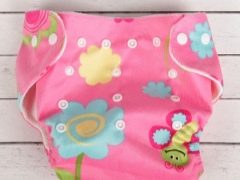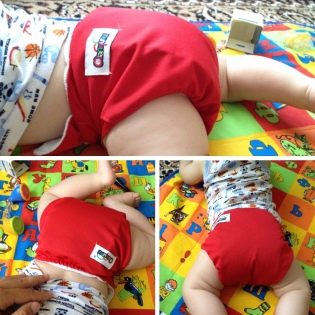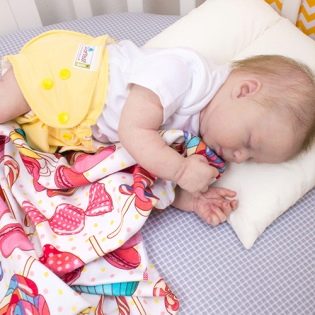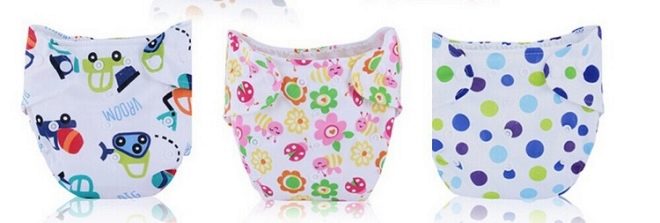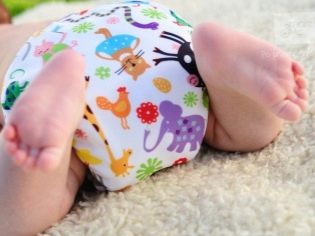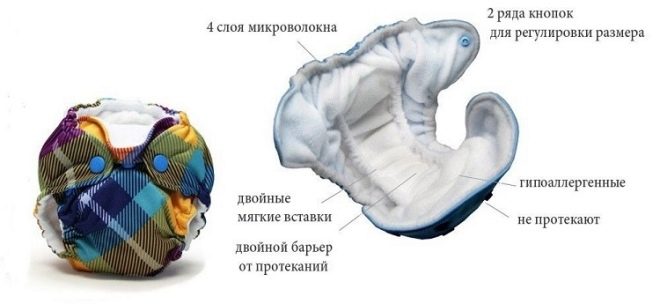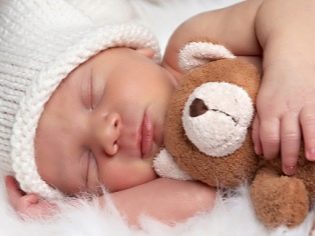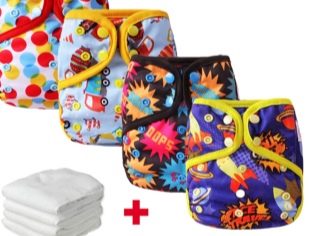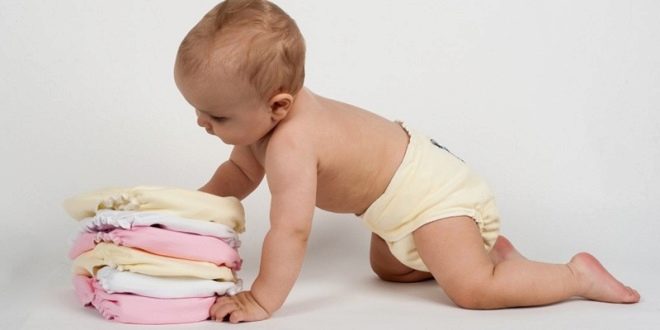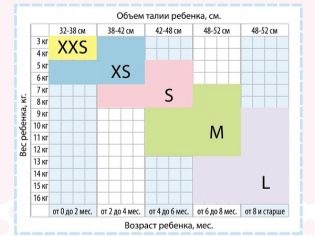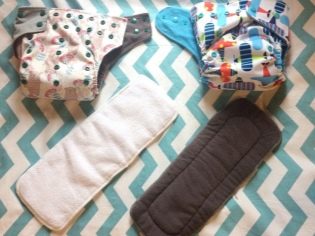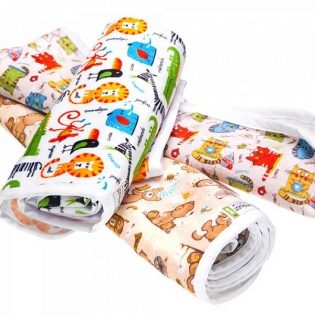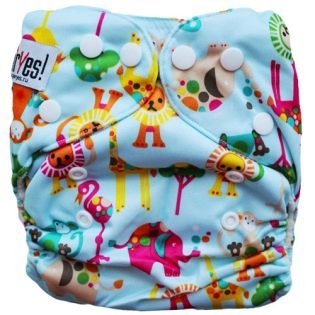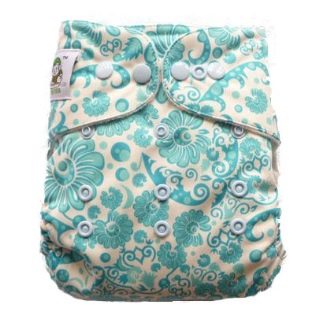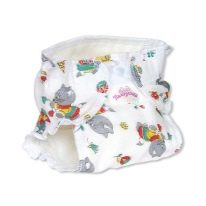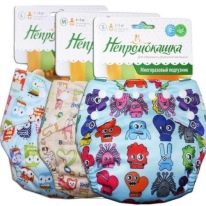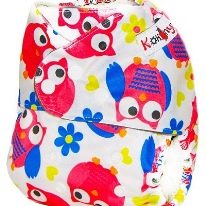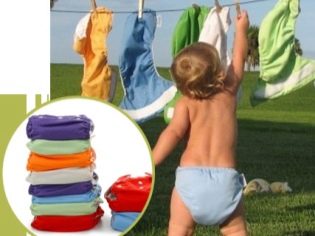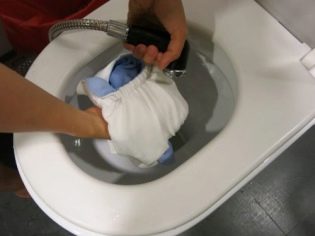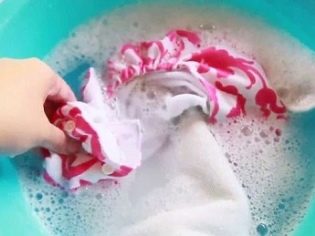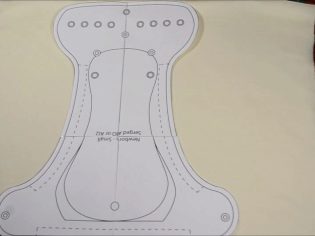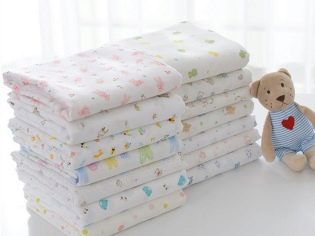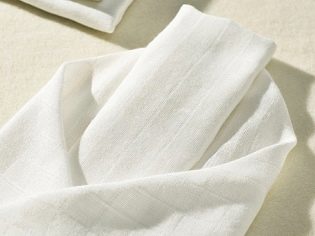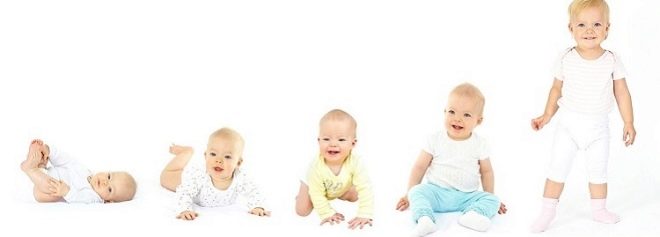Reusable diapers: types, rules of choice and use
By default, diapers are perceived as something disposable by default, which, of course, greatly simplifies the task of caring for a child due to the lack of the need for regular washings, but can thoroughly hit the family budget. In a situation where I would like to save money without returning to the "medieval" diapers, you should pay attention to diapers for reusable use.
What it is?
Externally, reusable diapers do not have any special differences from their disposable counterparts - they are all the same panties with velcro or buttons of the same shape and size. By eye, even a specialist often cannot distinguish a type of diaper. The difference is not in appearance, but in functional abilities. Disposable diapers actively absorb the waste generated by the baby, cannot be quickly filled and re-used, while the reusable version is specifically designed so that it can be washed.
The developers claim that recurring doubts about the hygienic nature of such a decision are groundless - with proper organization of the soap procedure, no microbes or visually visible contaminants remain on the product.
Many reusable models also require periodic replacement of the main absorbent liner, which allows for improved hygiene, while buying only one piece of a diaper will be much cheaper than a whole accessory. Of course, such a product, being designed for repeated use, is more expensive than a single disposable counterpart.
However, long-term use makes the first option more economical, and its high cost allows manufacturers to use more expensive materials in the process of creation, which will not irritate the skin of the child and will not cause dermatitis or other similar troubles.
Advantages and disadvantages
The fact that both reusable and disposable products get along in the market means that each of the options has certain advantages and disadvantages. Since the best solution is clearly not possible here, it’s worth exploring the characteristics of a reusable diaper to see if it is suitable for our purposes. It should start with a good one.
- On average, reusable models contain much less synthetics, being more natural. It has a positive effect on skin health.
- Reusable diapers are more expensive than disposable diapers, but such a one-time waste will last much longer - you can save several times, especially if you buy replacement liners in bulk. Parents who decide to give preference to disposable diapers often end up in a situation where the product literally has to be changed less often in order to save money at a certain stage, but then the cases of leakage and purchase become more frequent and losing their meaning. Once purchased with reusable diapers, you will not encounter such a problem.
- Reusable diapers delight the soul of those who sincerely worry about the environmental situation in the modern world.
Such a product is used not for several hours, but at least for several months, therefore it gives much less waste, without polluting the environment.
- A copy designed for many times does not allow to miss in choosing the size, as opposed to the one-time one - it is assumed that it “grows” along with the baby. Of course, different sizes are here, but it is much more difficult to make a mistake.
- Disposable diapers - this is a constant comfort, which is not conducive to schooling the baby to the pot - why should a child invent something new, if he is always good? Reusable copies still give some discomfort at the time of emptying, and this, oddly enough, plus - the baby who has reached a certain age, is ready to learn so that this does not happen again.
Cons, of course, are also present.
- As already mentioned, a reusable product does not absorb moisture as well as a disposable one. Yes, this property helps the child to get used to the pot faster, but it reaches an appropriate level of consciousness at about a year and a half, and up to this age, constant discomfort is not justified.
- In a disposable diaper, the absorbent layer is quite large and can be “loaded” in full, whereas for an instance for repeated use, the liner is relatively small, and, accordingly, it does not have a large volume. Each urination of the baby means the replacement of the liner, and after three hours you need to remove for washing and the entire diaper. If the child was noted "big accident", then you need to change the whole set at once. This means that the mother should be constantly aware of the condition of the diaper, so the reusable option is only for the cleanliness of the apartment, but not for the free time of the parents.
- It is not always possible to fully clean the pamper from the baby's surprise, and visible pollution becomes a huge problem for the mother - such a diaper no longer wants to be reused.
Kinds
Reusable diapers for children is not a specific type of diaper, but a whole class of baby care products, which is also divided, for example, for a specific purpose. In particular, there are models for newborns, but there are also for grown up babies, and this is not only and not so much about size, but about design features. Newly born calabs need a special cutout so that the product does not touch the umbilical wound, older children need an increased density of obtyagivaniya due to constant movement and a larger absorbent layer. Above it was said that reusable diapers do not absorb moisture too quickly and well, which is a minus, but at the time of training for the pot it will most likely be a plus.
In this regard, manufacturers sometimes set themselves the opposite task. Some work diligently to ensure that the absorbent layer works as productively as possible and provides comfort for a baby of the first year of life, while he is not yet able to realize the need for a pot, while others, on the contrary, create not flowing, but not too absorbing diapers that will child look for an alternative.
All reusable diapers and liners for them are classified as "eco". However, the latter can be produced from different materials, each of which also has its own advantages and disadvantages, namely:
- cotton-based fabric inserts (from flannel or biomarly) are valued for being fairly easy to wash, and they dry very quickly, but their absorption capacity is not so outstanding - you will have to either change it often or use it two at a time;
- carbon bamboo inserts they absorb liquid much better; according to this indicator, they even slightly resemble disposable diapers, but the fabric from such raw materials dries longer than cotton, and absorbs unpleasant odor even faster;
- microfiber it is perfectly washed off and almost never becomes a cause of irritation on the skin, but it is expensive, and it dries longer than cotton anyway;
- predicted by popular solution is combination of several materials at once in one insert - In this way, manufacturers try to combine the best qualities of different fabrics in one product.
Dimensions
The concept of a reusable diaper itself assumes that it does not have a specific size - it must be possible to adjust the product so that it fits the baby at any stage of its growth. This is true for the absolute majority of models for repeated use, but some companies produce separate lines for premature babies and the first three months of life, thus avoiding unnecessary leakages when the child is very small and the standard diaper does not cover it quite tightly. On most models, the size is adjusted using fasteners, for which there are three positions. For convenience, it is worth giving the approximate parameters of how to select the degree of procrastination.
- Small size, he's S, designed for children weighing 3–8 kg. If the buttons go in three rows, to obtain this size, the top row must be attached to the bottom.
- Average size or M partially overlaps with the previous one, but in general it is designed for a slightly different weight category - 6–10 kg. In this case, the top row of buttons clips to the middle.
- Large size, known as L, designed for the heaviest kids - 9-15 kg. The above buttons, the main task of which is to adjust the height of the diaper, in this case remain undone, giving a maximum of space.
Important! Find reusable diapers for children weighing over 15 kg is quite problematic. Most manufacturers believe that by this time the child is either already accustomed to the pot, or is about to get used to it.
How to choose?
In the case of disposable diapers, the choice is quite simple - you just need to buy several different pieces and see how practical and convenient they are. With reusable diapers, such a trick usually does not work, because you don’t need too much. Therefore, you should first carefully examine the packaging or any official information about the product on the Internet. It is necessary to find clear evidence that the product from this line suits your child well - by age, weight, sex, and so on. If there are any technical characteristics, for example, the duration of use of the liner without replacement, you should also pay attention to this. The fundamental point is also what inserts can be used - the characteristics of different types have already been described above.
Here you need to understand that no sane manufacturer will not criticize their own product, so the many advantages described by the firing company should not be too naive. It is necessary to look for information from those people who have already enjoyed similar products - good, today the Internet and specialized sites provide such an opportunity. Wherein do not make a conclusion on one comment, especially if it is one-sided. Any relatively popular product should have both advantages and disadvantages, so pay attention to both sides of the coin. And the one and the other in the reviews should be justified and confirmed by different people on different sites, otherwise there is a risk of running into the subjective opinion of the parents or the special needs of their child.
In any case, it is not always possible to immediately find the ideal option - if only because your child may have special needs. Therefore, it is undesirable to focus on the search for some one-man winner - it is better to determine at least 2-3 options that could claim victory.Having chosen the leaders, you should buy one reusable diaper from each of them - so you, without wasting too much money, will be able to determine which of the options is better, and in the future you will start from specific knowledge.
Not to mention such criteria as the cost of the product. The use of re-usable diapers is often resorted to by those parents who want to save, but you need to understand that blind choice in favor of the cheapest option is likely to disappoint - money is spent, and the desired result is not achieved due to the low quality of the product. For this reason, the price can be considered as a criterion only if there are two options that in all other respects seem to be completely equal.
Both options must first meet at least the minimum quality requirements, but if this condition is not met, then their value no longer matters.
Popular brands
It is difficult for an uninformed person to decide which reusable diapers are better for babies, since well-known advertised brands usually prefer to produce mostly disposable products. For this reason, even the names of the leading manufacturers of reusable diapers are not spoken to young parents, therefore, it is worth highlighting some of the popular brands of these children's accessories.
- Gloryes for inexperienced parents, they do not represent anything new - they are very similar to ordinary diapers, both in appearance and in the principle of donning. Their products are stunningly soft and allow free adjustment of the size, which, together with the declared two thousand washes, makes such a decision mandatory for consideration.
- Coolababy appreciated by many parents for improved protection against leaks. Children should also like this choice, because the materials used absorb moisture well and do not cause discomfort even in cold weather, and they also do not accumulate static electricity.
- "Pampusiki", as is often the case with domestic products, they are distinguished by a very affordable price, but they are often criticized for their quality - for example, they are not advised to use outside the house, since such a diaper is not very reliable. But the advantage of the product for home use is its naturalness and the absence of the greenhouse effect inside.
- "Nether", also being Russian products, is much more expensive, and a kind of "chip" is that the liner is inserted into the so-called pocket, which allows you to put the replacement part on top of the pocket, due to which sometimes the diaper can not be erased even after it was used for its intended purpose. Another feature of the brand is that it produces two different sizes of diapers, the separator between which is a weight of 9 kg.
- "Konopush" - This is another Russian brand, which is distinguished by positive characteristics, approximately reminiscent of the products of “Gummed”. There is only one size here, but you can use it up to two and a half years, and the main feature of the model range is that here the creators have worked on the aesthetic design of the products - such diapers are likely to be liked by their beauty.
How to use?
Use reusable diapers just about as much as the usual disposable, but some features are possible. For example, it is often recommended to wash even brand new panties first, since the absorbent layer begins to work more efficiently after only a few washes. A clean liner is inserted into the washed and dried diaper. Structurally, this may look different, but usually it happens by analogy with a pocket, but if the process is more complicated, it will necessarily be indicated in the package instructions.After that, you need to expand the product on a flat surface with the outer side down, and lay the baby on top of it.
Zip the product should be slowly, because here the size is adjustable, and the task of parents is to ensure sufficient density, not allowing leakage, but not to pass on the limbs or waist of the child.
Reusable diapers are not as durable as disposable ones, so they should be checked for fullness every two hours, otherwise leakage cannot be avoided. However, if you do everything in a timely manner, then there will be neither a big accident, nor the need for immediate washing of the entire diaper - you just need to replace the wetted liner. However, due to not the most prominent indicators of the absorption of the baby will have to bathe every time you change the liner. After such a procedure, in order to avoid the appearance of the greenhouse effect of the child, it is better not to don a diaper immediately - let him dry for 5–10 minutes in a natural way, just lying naked.
Self soiled liner it is not necessary to wash immediately, but at least rinse it under running waterotherwise it will be more difficult to wash off the dirt.
At the same time, it should not be too tight with washing the liner, to improve the process, use either baby soap or laundry detergent that does not provoke an allergy. The reusable diaper itself usually does not require washing or replacement, unless its inner surface remains wet.
Care Tips
The durability of any product depends heavily on how well it is cared for, so reusable diapers should be washed with a clear understanding of how to do it correctly, without harming the structure of the accessory. You can immediately please moms with the fact that most manufacturers do not impose restrictions on automatic washing, but still some specificity of the process must be observed.
- Before loading the liner or the entire diaper into the washer, first carry out its primary cleaning of impurities by placing it under a stream of water. Since the diaper needs to be checked regularly, pollution usually does not have time to get too much, so there is no point in turning the product in the machine along with all the dirt.
- Naturally, it is much more difficult to wash off the old and dried-up contaminants, so you shouldn’t pull too much with this procedure. A quick response will allow not only to achieve the actual purity of the panties and liners, but also allow you to do without stains that do not wash off.
It is logical that keeping the washing machine constantly turned on is not very convenient, so many mothers would prefer to lock the product manually - this option is also possible, only it is highly undesirable to soak the diaper beforehand.
- By the way, many mothers, trying to return the accessory to its original whiteness, use aggressive detergents with a whitening effect. Experts argue that this is not worth doing in any way, because the washed liner, which looks like new, actually loses some of its useful properties - aggressive chemistry destroys one of the membrane layers that contribute to more efficient absorption.
- Too hot water can also adversely affect the absorbent properties of the product, but manufacturers usually do not need to wash their products in very cold water - the recommended temperature is usually indicated within + 40– + 60 degrees.
After the diaper has been washed, it should be rinsed again thoroughly in clean water, and then hung out for faster drying.
How to do it yourself?
The need to spend a lot of time at home for the care of a child and the banal desire to save on accessories leads to the fact that some housewives are interested in the opportunity to independently sew a reusable diaper.As you can understand, this product is structurally much simpler than its one-time counterpart, some special materials are rarely used here, which means that the probability of successful self-creation of an analogue at home is quite high.
As the material for the liner is usually used gauze. The best and easiest method of manufacturing is to make a diaper on the model of an already finished factory fabric, which is suitable for your child in size and other characteristics. To do this, take a piece of cotton fabric of sufficient size and place the purchased sample on top of it unbuttoned. After that, you need to circle the contours, adding everywhere a few centimeters for allowance. Do not forget that this is only one side of the diaper, and there must be another.
Quite often, making a diaper at home, mothers do not bother with the creation of a pocket and liner. They just make inside another layer of gauze, folded three or four times, which fully corresponds to the size of the outer layer of cotton. The result is a kind of ordinary panties, only very thick - they can leak, but this requires quite a lot of liquid. When both layers are individually ready, they are put together and stitched along the contour. Where the product will clasp the child - in the places of the cut for the legs and waist - sew a thick elastic band. When both parts of the diaper are ready, they are stitched together, forming holistic panties.
A separate point is attaching mounts. Here, each mother is free in her preferences and can use ties, stickies or any other ways to fix the size. In any case, this manipulation is the last thing to do when the panties are generally ready.
Before you sew anything, it is advisable to measure the resulting product on the baby to make sure that it will fit it exactly.
Reviews of mummies and doctors
It should be noted that experts usually speak rather positively about the use of diapers for repeated use. If for the manufacture of such an accessory natural materials were used, then wearing it usually has a good effect on the health of the baby. At the very least, they leave this decision to the right to exist. Doctors usually think that diapers are not for the child as much as for his mother, so she is free to decide for herself what she likes more. In fairness, they note, this solution is not so economical - due to the fact that it has to be washed regularly, the costs of laundry detergent and electricity increase significantly, not to mention the fact that parental forces are spent much more than in the case of disposable diapers.
The most experienced mothers say that the question is not the principle choice between disposable and reusable products - they are too diverse, so they are simply used for different tasks.
So, at home, when the washing machine is at hand and there is time, it is practical to use diapers for repeated use, but at night, on a walk or at a party, disposable models are more appropriate - they are much easier to replace and throw away. It turns out a kind of golden mean between high costs with high comfort for disposable products and the risks of using reusable.
If we talk about feedback on reusable diapers, it should be recognized that they are criticized much more often than disposable ones. They are more susceptible to leaks, and this does not even always happen in the area of rubber bands - sometimes the product simply does not have enough thickness to retain moisture. Again, protection for a clean apartment is not only a diaper, but also the attention of parents, and relying on an accessory is dangerous - it will rather let down than pleasantly surprise.
There are positive comments on reusable products, but either parents managed to choose a really suitable model (which is also a very important point), or they are very patient people and it’s not a problem for them to constantly monitor the condition of diapers. In any case, it is worth trying such products, because it is better to form your own opinion than to trust someone else's contradictory comments.
On how to choose and use reusable diapers, see the next video from Dr. Komarovsky.
